– BLOG UPDATED 9/25/17
Some pool owners have a misconception that throwing shock into the pool and owning a salt chlorine generator forfeits you from having to deal with chemicals again. Unfortunately, this is not the case. Yes, you will worry less about certain chemicals, but the importance of a well-balanced pool remains.
Before attempting to operate your new saltwater chlorine generator, there are a few steps every pool owner should follow to ensure the best use of your system. Did you know that before you even operate your unit, salt must be added to your pool? Actually, you should evaluate your pool’s water chemistry as a whole. A properly balanced pool is not only essential to the performance of your chlorine generator but also important in protecting your pool equipment and swimmers from other potentially dangerous situations.
To help out new salt chlorine generator owners, we’ve created a chemical quick start guide before operating your chlorine generator.
STEP 1: Calculate Pool Volume

One of the first things you should become very familiar with is how many gallons of water your pool holds. This information is used frequently when trying to size your equipment correctly for your pool and when you’re adjusting chemical levels.
You can determine the number of gallons of water in your pool by using the formulas to the left. For non-standard shaped pools, it may be easier to break your pool into sections to calculate. Then, simply add all the sections for a total amount.
STEP 2: Adjust Your Salt Levels
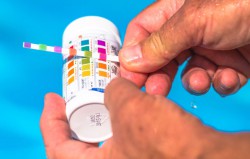 Before you do any adjusting to your salt levels, you first have to determine how much salt is currently in the water. We offer various pool water testing equipment on our site that you can purchase that will assist you in testing your water. The recommended salt levels are between 2700-3400 parts per million (ppm), with the ideal level being at 3200 ppm. (Some systems may require a higher minimum level. Check your manual for specifics)
Before you do any adjusting to your salt levels, you first have to determine how much salt is currently in the water. We offer various pool water testing equipment on our site that you can purchase that will assist you in testing your water. The recommended salt levels are between 2700-3400 parts per million (ppm), with the ideal level being at 3200 ppm. (Some systems may require a higher minimum level. Check your manual for specifics)
After testing the salt, determine how much you need to add until you reach the 3200 ppm mark.
Salt chlorine generators may indicate low salt sometimes and it prompts pool owners to add more salt. Then, once they test their levels, their salt PPM is extremely high. The reason this happens is due to a failure in the salt cell. Failure in your salt cell can trigger false readings. To ensure proper levels, always, always, always test your pool water. A simple water test can tell you where your pool water stands as a whole allowing you to make adjustments accordingly.

 STEP 3: Adjust Cyanuric Acid
STEP 3: Adjust Cyanuric Acid
Cyanuric acid (stabilizer) is essential to the performance of your chlorine generator system. Cyanuric acid is a mild acid that helps prevent the breakdown of chlorine due to the sun’s ultraviolet rays. If you live in a region where the sun is a frequent visitor, you may want to pay close attention to these levels. For cyanuric acid, the ideal level for outdoor pools is 60-80 ppm, while for covered pools it is 20-40 ppm. The ppm for indoor pools should be 0, as there is no need to add stabilizer to a pool not affected by the sun.
STEP 4: Adjust Free Chlorine
You should test and monitor your available free chlorine levels on a weekly basis. Free chlorine levels should remain between 1-3 ppm. You can lower your free chlorine by reducing the output setting on your generator. Also, consider increasing the pump runtime if you cannot maintain a high enough FC.
STEP 5: Adjust Total Alkalinity
The total alkalinity (TA) measures the total alkaline substance in your pool water. Alkalinity is the name given to the capacity of an aqueous solution to neutralize an acid. The ideal level for TA is 60-80 ppm. The results of improper TA levels range from corrosion of metal pool parts, staining of your pool, burning and itchy eyes, cloudy water, and reduced chlorine efficiency. You can increase the pool‘s TA using sodium bicarbonate (baking soda) and decrease the TA using muriatic acid
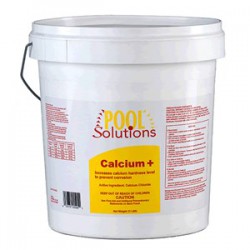 STEP 6: Adjust Calcium Hardness
STEP 6: Adjust Calcium Hardness
Calcium hardness is the measurement of the total amount of minerals that are found in your pool’s water. If you’ve heard the phrase ‘hard water’, it is simply referring to a high mineral content. Ideally, your total hardness should fall between 200-400 ppm, however, it may vary if you have a fiberglass or vinyl pool. Too much calcium hardness causes scaling in your pool and too little causes your pool water to become corrosive. While drinking ‘hard’ water is not necessarily harmful to one’s health, it can pose serious problems to your pool equipment.
- 50-300 ppm for vinyl (Do Not Add)
- 220-320 ppm for fiberglass
- 350-450 ppm for plaster
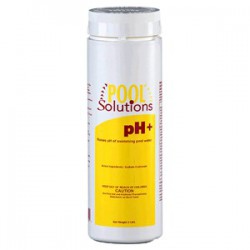 STEP 7: Adjust pH
STEP 7: Adjust pH
pH is the measure of how acid/alkaline the pool water is. Pools with a pH of less than 7 are considered acidic. The ideal pH level for your pool is 7.2-7.8. If your pH is too low, the water can become corrosive to your pool equipment. If your pH is too high, the chlorine becomes much less effective for sanitation. Pools with salt systems tend to have a higher pH level. Because of this, you will probably be adding a little more acid to your pool than most traditional chlorine pools. If you don’t keep your pH levels in check and they continue to rise, calcium scaling along your tile walls begin to develop. Additionally, calcium scaling also affects your saltwater cell, thus shortening the overall lifespan of the cell itself.
Water chemistry for saltwater pools slightly varies from traditional chlorine pools. If you need advice on balancing your saltwater pool, post your results in the comments section and we’ll do our best to help you get your pool balanced.
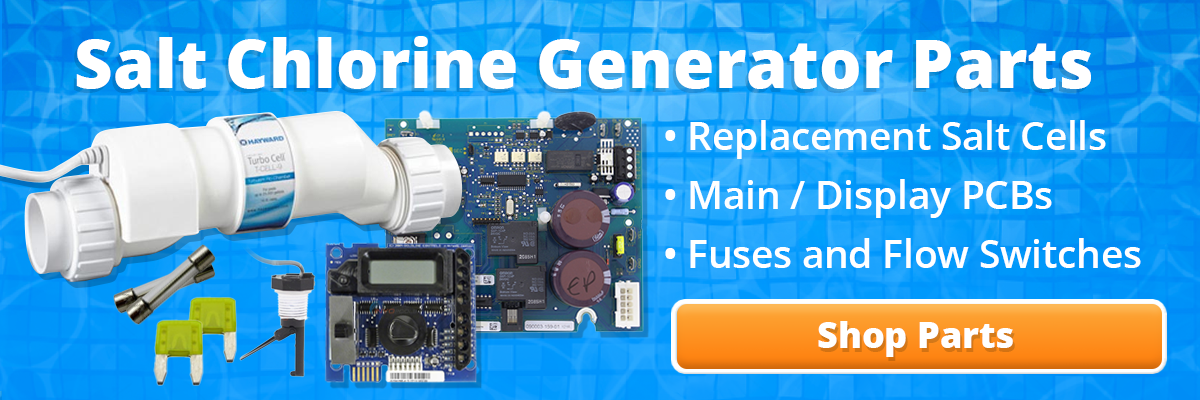
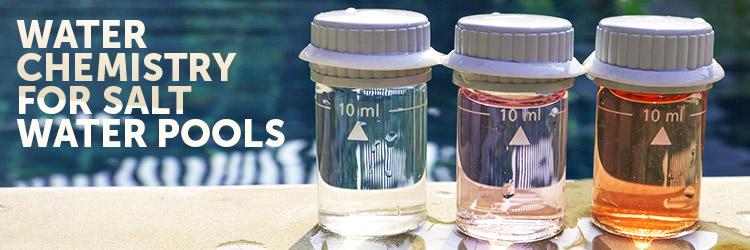


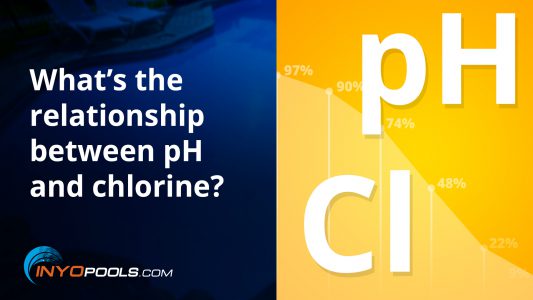
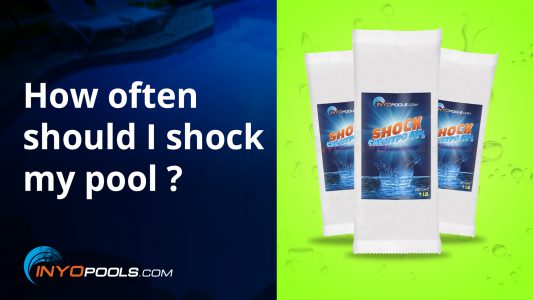






Do you offer a pH tester that shows a higher range for use with salt water pools? With minimal acid my test kit maxes out at 8.2 pH.
The pH range for a test kit I found was 8.4. If you search for the “High Range pH Test Kit” through google or bing, there are specialty options that go as high as 8.8. I presume pool test kits top out at 8.2 because it is rare a pool would be out of balance that badly, and if a pool did reach those levels, it is likely a dump-and-fill reclamation project.
Thanks for your answer. I am finding that my salt water pool needs more acid than I am comfortable putting in. I have learned from previous spa ownership that it is not good to add too many chemicals. Helps to promote drain and fill.
Hi
Thanks an interesting article
Do you have any recommendations for test equipment- – wo have a small above ground saltwater pool with a intex chlorine generator. We struggle with test strips /ph meters to get any two methods/strips to give a similar result.
I have same problem with an in ground saltwater pool. I use two different methods to test and get two different results.
The best thing to do when dealing with conflicting home test results is to get a sample tested at a local pool store. These tests are usually free and should be more accurate than most home kits you can buy.
Taylor drops are much better than strips
I have a 30,000 gallon 20×44 salt water pool. Chlorine is good 1.5ish, ph is usually in good range 7.2 ish. The salt level is good. The biggest problem is alkalinity at around 250-260ppm. We have added many gallons of MA over several weeks and the numbers have come down from 320 but should we keep adding MA? Or just work with PH up or PH down products?
Trying to balance pool pH above 8.2 purple,CL above 3.0 dark orange.Salt water pool,fiberglass, inground, with auto safety cover closed all the time,now. Chlorine generator down to 10%. pool size is 4′.4″deep in shallow,6’6″deep in deep end.14.5 wide x 35′ long.
When calculating gallons do I need to divide the differance between the shallow and the deep.
I would use a regular old pool volume calculator top get a general idea.
Hey Matt. Just bought a house with pool and the company that opened the pool didn’t do a great job adjusting the chemicals as there is algae growing as easily as overnight. I just tested the water and got readings as follows but not sure what chemicals I should be using for each and in what order, would you be able to help?
PH – 6.8
Free chlorine – 0
Total Alkalynity – 0
Stabilizer – 0
Salt – 3.8 or 1040ppm
It looks like you need to increase everything; your pH, alkalinity, chlorine, stabilizer, and salt are all low. In the article under each heading, we provide the correct ranges for the various chemicals.
First, you need to calculate the number of gallons in your pool, then you can use a pool math calculator to judge how much of each water balancer you need to add.
We are new salt water pool owners and we recently opened up our pool. We can’t seem to get our pool balanced. When trying to balance a pool, is there a preferred order when trying to correct? Our pH is low (7.0) , Alkalinity High (175), Total Chlorine Low (0.71), Cyanuric Acid Low (18), Salt 3816, Total Hardness (195), Copper (0.3).
Also, Total dissolved Solids, I have read can be higher in salt water pools. Do you know what the recommended range is for the salt water pool?
I almost forgot to mention, we live in rural Illinois, so our Phosphate Levels are also really high (~4500).
Hi! We have newly built salt pool..7000 gallons.
I went to the pool store to have the water tested today and our chlorine is at 0!! PH was 8, alkalinity was 120, stabilizer was 60. I don’t really want to shock the pool with liquid chlorine so how do I slowly bring it back? I added the muratic acid already and will test again tomorrow. Am I on the right track to bring up the chlorine levels? Water is clear. Trying to figure out how these chemicals work together???
I have a salt water pool in an area of extremely high calcium. The chemical balance has been good with the exception of calcium – which is off the chart high. I added 2 liters of Zodiac Calcium Down to the 40000 liter pool and overnight the pool went from lovely and clear to VERY milky with LOTS of ‘white powder’ coating the pool steps and presumably the bottom.
I assume this is calcium particles no longer held in solution?
The instructions stated the water color would change and to run the filter for 72hrs. So far it’s been 48hrs. I’ve backwashed twice. The backwash looks like white paint.
Anything else I can do or is it just a matter of patience as the calcium is filtered out?
To add the calcium is so high that within 24-48hrs of cleaning the elements they are heavily coated with calcium and then it starts breaking off and depositing chips of calcium into the pool. A few hours before adding the calcium down I added 80kgs of pool salt as we had just come out of a 3 week period of persistent rain.
I’d give it another 24 hours if I was in your situation; a lot can change in that time. Did you add pool shock and an algaecide at the same time? This common chemical mistake can also cause milky water.
Also, I am very skeptical of “calcium down” chemical additives. The most reliable way of getting your calcium down is draining a portion of your pool and then refilling with fresh water. But if your local water has a high calcium content, it likely is your only option.
Thanks.
I’d a.ready given it another 24hrs – then drained the pool. There really was no change in milkyness and the bottom of the pool was covered in white slime – I still think it was calcium.
Gave the pool and good cleaning with our water blaster and it’s currently refilling.
Won’t make that mistake again.
Our pool builder continues to tell us that our Chlorine levels do not matter in our Salt water pool. We’ll take the water to get tested and they’ll say our chlorine is high, like 7. Salt level is ok. So the pool store says to turn our chlorine generator down to like 10-20%. Our pool builder came out for a service on our equipment and put it back up to 60%, saying that chlorine readings on a salt water pool don’t matter. Is this true? I am most concerned for our health and long term life of our equipment. Any insight is appreciated!!
Tell your pool builder to stop touching the equipment, because he doesn’t know what he is talking about. Yes, the chlorine level matters in any pool that uses chlorine as its main sanitation chemical. Your Free Chlorine (FC) reading should be between 1 – 3 ppm.
I am having a problem of keeping my saltwater pool balanced. The pool has a waterfall from the spa. No matter what I do the pH goes up every three to four days. I then add muriatic acid to get the pH back down and before you know it my total alkalinity is down and I need to add baking soda. Them the Merry go round starts again. Chlorine is 2, pH is 7.6, total alkalinity is 80, hardness is 280, and my cyanuric level is 50. I have the saltwater chlorinator off as water temp is 46. I have a peeblesheen finish. What am I doing wrong, or is this something I need to live with.
You’re not really doing anything wrong. But if you run your waterfall a significant amount of time then you are going to continue to have pH issues. I’d only run the waterfall when it was necessary (like parties) to prevent the spike in pH.
This is an interesting article. There is one point where there seems to be conflicting views in the industry and that is the relationship between FCL and CA. For salt water pools the consensus seems to be about keeping the CA between 60 – 80ppm ( let’s say 70). Now due to the higher CA levels there is a lot a indications that the FCL levels need to be higher – the proposed formula is to put the FCL = 7.5% x CA. Using the proposed CA target level of 75ppm, this puts the FCL target around 5-6ppm. In your article you indicate still keeping the FCL between 1-3ppm. Interested in your thoughts. Thanks.
Hi,
Salt-water pool 20-30′ plastic liner
According to my home water test kit:
pH=72
Total Alkalinity = 220
How do I get my alkalinity in line with 60-80 ppm recommendations without affecting my pH?
To lower your pH, add muriatic acid or pH decreaser.
Calcium is too low and so is Ph in my saltwater pool. What should I do?
You’ve basically answered the question already; your pH and Calcium are too low, so that means you will need pH and Calcium Hardness increaser. For all your other pool chemistry balancing needs, visit this page, Pool Balancers – INYO Pools.
Hello
I have a Intex sand filter and salt water system
Model EXO20110-1
6543 gal steel frame round vinyl
Free chlorine is ok
On test strip:
TA LOW
PH LOW
CALCIUM HARDNESS LOW
What chemicals and amounts do I need to get these in the ‘ok’ zone?
I have a hayward saltwater cell, my salt is low, because I’ve been trying to raise my stabilizer levels and my TA. Well my stabilizer is in range (50) just today, and my TA is now 120. Now I want to raise my PH it is 6.8. How do I raise it without raising my TA? My FC and TC are both zero right at the momoment. I do have a waterfall. Do I just let aeration raise it?
I work on 106000 gal Pool salt levels are at 3600-3800 but chlorine levels are low all the time. I thought salt should turn into chlorine am I missing something?
What model salt chlorine generator do you have installed on your pool?
I have a 4400 gallon salt water pool and I’m having problems with all of my levels. All are low but the free chlorine is very high. What do I do?
Can you provide the results of your latest water test so I know what we are dealing with?
I have a 345 gallon, salt water spa and am having problems balancing the ph and the alkalinity.
Alk is 180. Ph is 6.8 and sometimes lower. Salt is 1750. Hardness, Bromine and Chlorine are good.
I drained it and started over and it still creeps back to the same problem. It does not get direct sun and I live in Montana. Suggestions? Thank you!!!
I have salt water pool. Chlorine level is perfect but ph is low. As you mentioned that salt water pools have high ph and you have to add acid then why my pool have low alkanity. There is enough salt in the water.
Have you recently added acid to the pool? Or some other pH-reducing agent? That would explain it.
I have a salt water pool for two years and am having trouble balancing the Total Alkalinity, which is often low (40). I have the water tested at a pool store and I follow their recommendations to add Sodium Bicarbonate at the recommended dosage, turn off the acid bath for a few hours until the powder dissolves. Recheck the water and add more if needed to bring TA to ideal levels. It stays good for 7-10 days. Then goes off again. As a result my pool has become green three times this year! How do I maintain a perfect balance?
My pool is 8×4 meters wide, 1.6 m at the deep end (48 cubic meters, correct?). The latest pool water reading is pH 7.8, Free Chlorine +10, Total Alkalinity 40, TDS 5.54, and Cyanuric Acid 30. I have a Zodiac Tri Expert with pH and ACL auto adjustments. Six weeks ago I calibrated the pH and ACL electrodes, and have cleaned the salt cells, but there is again build-up in the cells so I need to again clean them.
Please advice.